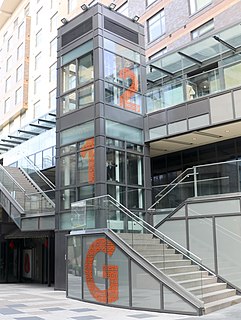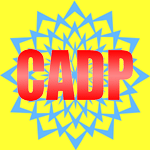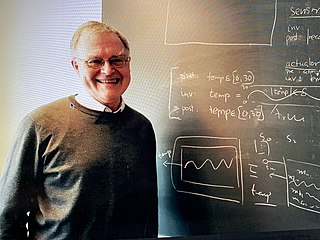Related Research Articles

Discrete mathematics is the study of mathematical structures that are fundamentally discrete rather than continuous. In contrast to real numbers that have the property of varying "smoothly", the objects studied in discrete mathematics – such as integers, graphs, and statements in logic – do not vary smoothly in this way, but have distinct, separated values. Discrete mathematics therefore excludes topics in "continuous mathematics" such as calculus or Euclidean geometry. Discrete objects can often be enumerated by integers. More formally, discrete mathematics has been characterized as the branch of mathematics dealing with countable sets. However, there is no exact definition of the term "discrete mathematics." Indeed, discrete mathematics is described less by what is included than by what is excluded: continuously varying quantities and related notions.
In computer science, communicating sequential processes (CSP) is a formal language for describing patterns of interaction in concurrent systems. It is a member of the family of mathematical theories of concurrency known as process algebras, or process calculi, based on message passing via channels. CSP was highly influential in the design of the occam programming language and also influenced the design of programming languages such as Limbo, RaftLib, Go, Crystal, and Clojure's core.async.
In the context of hardware and software systems, formal verification is the act of proving or disproving the correctness of intended algorithms underlying a system with respect to a certain formal specification or property, using formal methods of mathematics.

In computer science, model checking or property checking is a method for checking whether a finite-state model of a system meets a given specification. This is typically associated with hardware or software systems, where the specification contains liveness requirements as well as safety requirements.
In logic, temporal logic is any system of rules and symbolism for representing, and reasoning about, propositions qualified in terms of time. It is sometimes also used to refer to tense logic, a modal logic-based system of temporal logic introduced by Arthur Prior in the late 1950s, with important contributions by Hans Kamp. It has been further developed by computer scientists, notably Amir Pnueli, and logicians.
In logic, linear temporal logic or linear-time temporal logic (LTL) is a modal temporal logic with modalities referring to time. In LTL, one can encode formulae about the future of paths, e.g., a condition will eventually be true, a condition will be true until another fact becomes true, etc. It is a fragment of the more complex CTL*, which additionally allows branching time and quantifiers. Subsequently, LTL is sometimes called propositional temporal logic, abbreviated PTL. In terms of expressive power, linear temporal logic (LTL) is a fragment of first-order logic.
In computer science, the process calculi are a diverse family of related approaches for formally modelling concurrent systems. Process calculi provide a tool for the high-level description of interactions, communications, and synchronizations between a collection of independent agents or processes. They also provide algebraic laws that allow process descriptions to be manipulated and analyzed, and permit formal reasoning about equivalences between processes. Leading examples of process calculi include CSP, CCS, ACP, and LOTOS. More recent additions to the family include the π-calculus, the ambient calculus, PEPA, the fusion calculus and the join-calculus.
Bunched logic is a variety of substructural logic proposed by Peter O'Hearn and David Pym. Bunched logic provides primitives for reasoning about resource composition, which aid in the compositional analysis of computer and other systems. It has category-theoretic and truth-functional semantics which can be understood in terms of an abstract concept of resource, and a proof theory in which the contexts Γ in an entailment judgement Γ ⊢ A are tree-like structures (bunches) rather than lists or (multi)sets as in most proof calculi. Bunched logic has an associated type theory, and its first application was in providing a way to control the aliasing and other forms of interference in imperative programs. The logic has seen further applications in program verification, where it is the basis of the assertion language of separation logic, and in systems modelling, where it provides a way to decompose the resources used by components of a system.

In computer science, concurrency is the ability of different parts or units of a program, algorithm, or problem to be executed out-of-order or at the same time simultaneously partial order, without affecting the final outcome. This allows for parallel execution of the concurrent units, which can significantly improve overall speed of the execution in multi-processor and multi-core systems. In more technical terms, concurrency refers to the decomposability of a program, algorithm, or problem into order-independent or partially-ordered components or units of computation.
Interval temporal logic is a temporal logic for representing both propositional and first-order logical reasoning about periods of time that is capable of handling both sequential and parallel composition. Instead of dealing with infinite sequences of state, interval temporal logics deal with finite sequences.
Zhou Chaochen is a Chinese computer scientist.
The study of time perception is a field within psychology, cognitive linguistics and neuroscience that refers to the subjective experience, or sense, of time, which is measured by someone's own perception of the duration of the indefinite and unfolding of events. The perceived time interval between two successive events is referred to as perceived duration. Though directly experiencing or understanding another person's perception of time is not possible, such a perception can be objectively studied and inferred through a number of scientific experiments. Some temporal illusions help to expose the underlying neural mechanisms of time perception.
The ACM–IEEE Symposium on Logic in Computer Science (LICS) is an annual academic conference on the theory and practice of computer science in relation to mathematical logic. Extended versions of selected papers of each year's conference appear in renowned international journals such as Logical Methods in Computer Science and ACM Transactions on Computational Logic.

Prof. Zhiming Liu was a computer scientist. He studied mathematics in Luoyang, Henan in China and obtained his first degree in 1982. He holds a master's degree in Computer Science from the Institute of Software of the Chinese Academy of Sciences (1988), and a PhD degree from the University of Warwick (1991). His PhD thesis was on Fault-Tolerant Programming by Transformations.

CADP is a toolbox for the design of communication protocols and distributed systems. CADP is developed by the CONVECS team at INRIA Rhone-Alpes and connected to various complementary tools. CADP is maintained, regularly improved, and used in many industrial projects.
TAPAS is a tool for specifying and analyzing concurrent systems. Its aim is to support teaching of process algebras. Systems are described as process algebra terms that are then mapped to labeled transition systems (LTSs). Properties can be verified by checking equivalences between concrete and abstract system descriptions or by model checking temporal formulas over the obtained LTS. A key feature of TAPAs that makes it particularly suited for teaching is that it maintains a consistent graphical and textual representation of each system. After a change in the graphic notation, the textual representation is updated immediately; but after textual modifications, the update of the graphical representation has to be manually triggered.

TLA+ is a formal specification language developed by Leslie Lamport. It is used to design, model, document, and verify programs, especially concurrent systems and distributed systems. TLA+ has been described as exhaustively-testable pseudocode, and its use likened to drawing blueprints for software systems; TLA is an acronym for Temporal Logic of Actions.
Paritosh K. Pandya is an Indian computer scientist based at the Tata Institute of Fundamental Research (TIFR) in Mumbai, India.

Anders Peter Ravn was a Danish computer scientist.
References
- ↑ Zhou Chaochen, C. A. R. Hoare and Anders P. Ravn, A Calculus of Durations, Information Processing Letters , 40(5):269–276, December 1991.
- ↑ Zhou Chaochen and Michael R. Hansen, Duration Calculus: A Formal Approach to Real-Time Systems. Springer-Verlag, Monographs in Theoretical Computer Science, An EATCS Series, 2003. ISBN 3-540-40823-1.
- ↑ DCVALID: A tool for model-checking Duration Calculus formulae, TIFR, India.
- ↑ IDLVALID: Model checking dense time Duration Calculus formulae, TIFR, India.